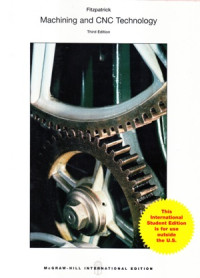Text
Machining and CNC technology
Programmed machine tools now represent nearly 100 per¬cent of manufacturing and, of greater impact to you, of new jobs. Entry-level people usually start in the shop as CNC operators. Flexible and friendly, the machines and program¬ing systems are so quick and easy to learn that they are now practical even for one-of-a-kind work such as mold making and die work, as well as production. Schools integrate and teach CNC as an entry-level subject—starting from the first lesson on the first day.
This book was specifically written to serve this type of modern student. To do so, subjects have been grouped into four large career partitions:
Part 1 Introduction to Manufacturing
Manufacturing is a world of its own. Chapters 1 through 8 are designed to open the door. They provide the background needed to fit into the shop, to understand the rules, to read and interpret the drawings, to be comfortable with extreme accuracy, and especially to be safe.
Part 2 Introduction to Machining
Chapters 9 through 16 teach how to cut metal the right way. These lessons assume that you'll eventually perform them on CNC equipment, but will probably practice first on manu¬ally operated machines because they are a simple, safe place to learn setups and operations.
Part 3 Introduction to CNC
Now we get to the text core: how to apply Parts 1 and 2 to setting up, programming, and running CNC machine tools. In Chapters 17 through 24, we will learn how to profession¬ally manage a CNC world. Because they move at lightning speed with lots of power behind them, safety must be inte¬grated into everything we study.
Part 4 Advanced and Advancing Technology
Chapters 25 through 29 set the tone for your career after graduation. The best is yet to come, so let's get started!
So, many thanks to those who are using my book to n your manufacturing careers. It's an honor to be your instruc¬tor. Here's what I can pass on about our trade.
Ketersediaan
Informasi Detail
- Judul Seri
-
-
- No. Panggil
-
670.42 Fit m
- Penerbit
- New York : Mc Graw-Hill., 2014
- Deskripsi Fisik
-
xviii, 856 hal. : il. ; 28 cm.
- Bahasa
-
English
- ISBN/ISSN
-
9781259060533
- Klasifikasi
-
670.42
- Tipe Isi
-
-
- Tipe Media
-
-
- Tipe Pembawa
-
-
- Edisi
-
Ed. III
- Subjek
- Info Detail Spesifik
-
-
- Pernyataan Tanggungjawab
-
-
Versi lain/terkait
Tidak tersedia versi lain
Lampiran Berkas
Komentar
Anda harus masuk sebelum memberikan komentar

 Karya Umum
Karya Umum  Filsafat
Filsafat  Agama
Agama  Ilmu-ilmu Sosial
Ilmu-ilmu Sosial  Bahasa
Bahasa  Ilmu-ilmu Murni
Ilmu-ilmu Murni  Ilmu-ilmu Terapan
Ilmu-ilmu Terapan  Kesenian, Hiburan, dan Olahraga
Kesenian, Hiburan, dan Olahraga  Kesusastraan
Kesusastraan  Geografi dan Sejarah
Geografi dan Sejarah